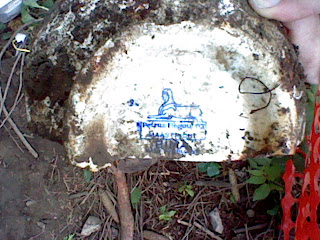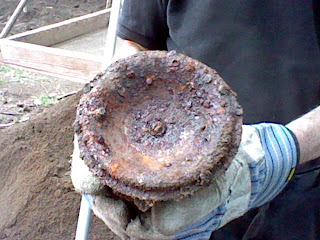Hello Everyone,
Thanks again to all of you who came out this past weekend. We had a nice mix of new people and hardened four week "veterans" and had our biggest
turnout for a Sunday yet! Everyone worked really hard we managed to get quite a bit done. Thank you!
We are for sure going to need another weekend to finish and there is still some heavy (and not so heavy) lifting to do, so the final push is on.
There are six one metre square units that need to be excavated (as well as the features once they are exposed) and we will be missing a few of our
regulars. If you can spare some time or think of anyone who would be willing to help out it would be much appreciated. This is such an important project and we need all the help we can get.
We will again be starting at 9:00 on both days. If you need to come later or leave early that is no problem at all. Please remember to wear your steel toed shoes or boots and bring a pair of work/gardening gloves.
Hope to see you on Saturday,
I had just entered a week about conservation in the Coursera course "Archaeology's Dirty Little Secrets" and was looking to do one of the three exercises but wasn't quite sure which one until this call came in. I decided to head down to the project site and see what was happening.
Here is a link to their website.
I arrived down there and was greeted by the archaeologist who was very pleasant and willing to share what was going on around the site. He explained some of the history of the site and what to look for as well as how far down to dig before stopping.
A BIT OF INFORMATION:
At the time this chapel was constructed the Thames River flowed differently (it was diverted to create a road extension), during that time it was on a floodplain which meant that the river would flood from time to time and bring dirt and mud up to where the site is. He said its the reason why the bottles they have found have been mostly intact. The area was also slightly marshy and it's why they built there. Coming from the United States they didn't have a lot of money, but once they did they pooled their resources and bought the land and built their chapel. The irony of the situation is, that years later when the railway came in, their land was right on top of it and that made it more valuable.
From about 1861 onward the house was a residence. I'm not sure when they put the added-on kitchen there, but it was definitely not there when the chapel was a chapel.
This site is in the evaluation stage to determine whether or not more work needs to be done. After the stage we were doing is finished I believe he said they were planning to excavate the top layer of the entire area to see if any more features present themselves. He said they had been unable to find a well or a privy as of yet.
The Chapel is also going to be moved to the church where most of the congregation moved to later in time. It will be used as a community center and for other purposes. (see the website for more information). They are currently raising funds to try to move the structure.
Once the structure moves, John is going to look below where the foundation is to see what interesting things might be there. He will also be looking to solve the rumor that there was a "tunnel" or "hiding place" under the building anywhere.
We were told that what we wanted to do if we were digging was to go down to the area where the soil changed color from black to a reddish color. (The reddish color is actually sandy). As you can see below in the pictures, someone when they wanted to dump something dug down into that reddish colored soil to bury their garbage.
With all that information relayed and understood we were ready to begin. I had the wrong shoes so I waited my turn while my step-daughter and husband went in to get started.

I stayed outside the fence in my sandals and watched the fun. It didn't take long for the fragments of porcelain to start showing up. There were some large pieces recovered from the "pit" nearby and they were finding little bits of similar colored pottery. There were two different bowls found there but I have a couple of pictures of the blue and white one.
We were finding tons of nails and a possible bowl from a pipe when the guys in the pit we were working on called John over. They had found a "clump" of something. Couldn't quite tell what it was at first.
They did some excavating around it and from the top and this is what was found.
As they continued to work we pulled out:
None of us were sure, but it almost looked like the cans had been burned and in some cases they seemed "stuck" together.
 | |
| Metal pail full of cans |
We also found a couple more bottles.
and this one:
There were also some other things found we couldn't figure out: (we wish them luck back at the office)
 | |
| The "ball" inside looks like it might be made of copper (my guess because it looks metal and looks like it's going "green") |
It was really a lot of work. The day for us ended with filling a finished pit and watching the can excavation.
All in all it was hard work, some of the found objects were really tiny and hard to see. A couple times we confused bark and charcoal from their stove dumps for objects, but once we were clued in it started to get smoother.
Here are a few more shots of the site.
 |
| A batch of bottles found before we arrived |
 |
| Site facing west towards parking lot |
 |
| Parking lot the company wants to expand on |
 | ||
| This signboard was near a very large pit that was being worked on |
So the found items I saw today were:
-broken pieces of what look like plate glass
-charcoal (by the ton!)
-old bent nails
-a very tiny fragment of lantern glass (that was his guess because of the way the glass had solarized (changed color))
-sardine and TONS of other cans of various types
-bottles
-rusty bucket with handle still attached
-possible pipe fragments
-a piece of cow backbone (well butchered because of the even cuts), and a piece of cow horn (that's what it looked like to me)
-yellow bricks (both yellow and red bricks were made in our city Red in the North end, Yellow in the south)
-one bottle with river water? inside of it trapped by the cork
-one walnut shell :)
I will try to go back there regularly to see how things are going and what they might have discovered since I was last there. But I did enjoy my time on the site and it was great helping out.
I am glad that they are trying to save the building it is definitely better than what the cab company had in mind for it. (demolition).
















